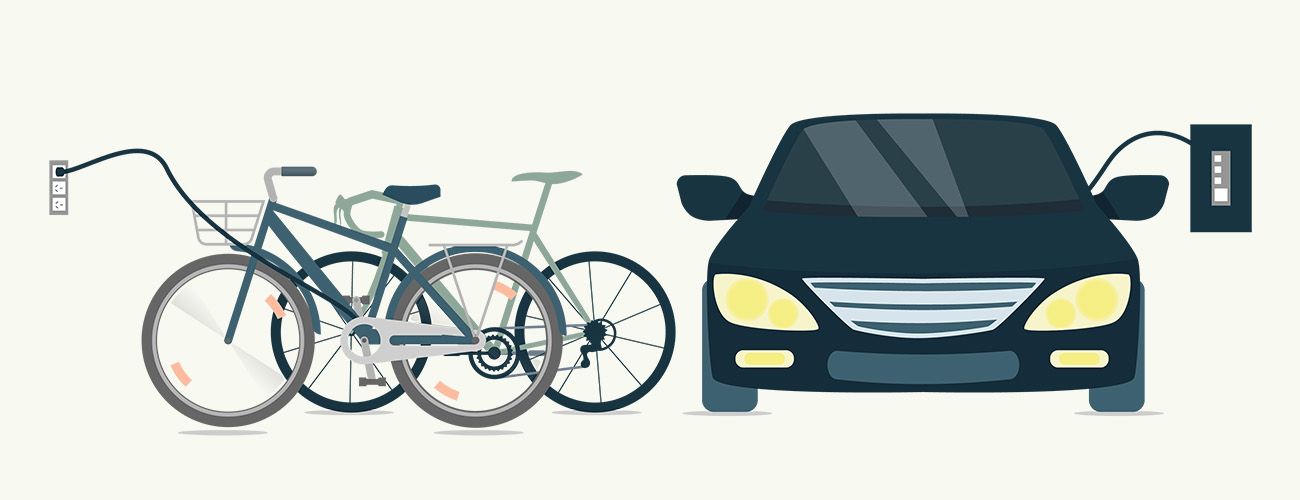Transport

 Cycling
Cycling Cycling
Cycling is an environmentally friendly alternative to driving, so if you are frequently making shorter trips, consider getting on your bike or investing in an ebike.
 Ebikes
Ebikes Ebikes
Ebikes have become increasingly popular over the last few years and are affordable and accessible. They make cycling an easy option, even in hilly areas or for longer distances. An ebike could even replace your second car!
 Electric Vehicles
Electric Vehicles Electric vehicles
Electric vehicles (EVs) and hybrid vehicles (HVs) are growing in popularity and are becoming more affordable. Charging an electric vehicle off your solar panels or other green electricity makes it a more environmentally friendly alternative to regular cars.
 EV Charger
EV Charger EV charger
Electric vehicles are going to become the standard soon, so if you are building or renovating your home it's a good idea to consider setting up the electrical wiring to be ready for a future charging station.
![]() Click on each icon in the image above to get instant tips
Click on each icon in the image above to get instant tips
It’s no secret that transport is a large contributor to Australia's carbon emissions - in fact, cars are responsible for roughly half of all transport emissions in Australia. The good news is there are many ways to become more environmentally conscious when it comes to transport. A few alternatives to consider are:
- Cycling
- Electric vehicles
- Hybrid vehicles
- Public transport
- Carpooling
- Moving in-person meetings online
Cycling
Cycling has long been an environmentally friendly - and healthy - alternative to driving. However, if the prospect of cycling everywhere seems daunting or you live in a hilly area, you may consider purchasing an ebike.
These have become increasingly popular over the last few years and as such are affordable and accessible. The added electric element makes commuting far easier - particularly where there are hills or long distances involved.
To charge your ebike all you need is a standard powerpoint. As the ebike should be charged regularly to extend the battery life, it helps to have a powerpoint right near your bike rack to make charging convenient.
Electric vehicles (EVs) and hybrid vehicles (HVs)
Electric vehicles (EVs) and hybrid vehicles (HVs) have also been making their way onto Australian roads in recent years. While these options are not financially accessible for everyone yet, there are options which make these alternatives more affordable. For example, a quick search online of “Electric vehicle bulk buy in >your area<” may yield some surprising results, such as the 2021 Geelong Electric Vehicle Bulk Buy. For more information about Victoria’s Zero Emissions Vehicle Future, head to Energy Victoria.
When it comes to any electric form of transport - be it an ebike or an EV - it’s important to ensure that your house is correctly set up for charging. Both can be charged using a standard 240-volt domestic wall socket; however, an EV may take up to 48 hours to fully charge in this manner. Purchasing a fast charger for your home will alleviate this issue and future proof your home as EV’s become more common in Australia.
EV Chargers
Various charger models are available and most require a dedicated electricity circuit. Charging plugs and socket types can differ depending on the type of car you have, and you may need an adapter. Some charge cables are portable so that you can take them with you when travelling.
Purchase and installation of an EV charger can cost several thousand dollars, but if you are building a new home or thinking of buying an EV it will be worth the investment.
If you have solar panels, you can align your car charging period with the time of day that your solar panels are producing the most energy. That way, you will save costs and reduce your electricity consumption from the grid at the same time.
Public transport and carpooling
Of course one of the most accessible, affordable and universal ways to reduce your transport emissions is public transport - so check out your local bus, train or tram timetable. If public transport doesn’t quite suit your work commute, consider carpooling with coworkers - two people in one car equals half the emissions!
